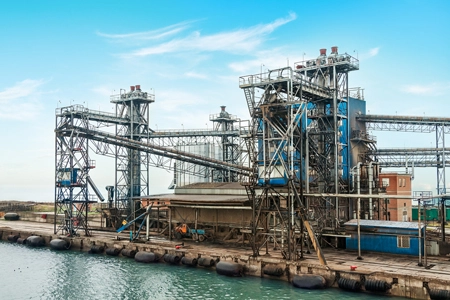Oil and Gas Industry

Oil & Gas Industry in India
- The Oil and Gas industry in India is set for a sea change with recent developmental ambitions of the Government of India – 175 GW of installed capacity of renewable energy by 2022, the aim to achieve 100 smart cities mission, 10% reduction of oil and gas import dependence by 2022 and provision of clean cooking fuels.
- The estimated conventional hydrocarbon resources in 26 sedimentary basins stood at 41.87 bn tonnes (oil and oil equivalent of gas), an enormous increase of about 49% in comparison to the earlier estimate of 28.08 bn tonnes.
- India is the second-largest refiner in Asia after China. It is emerging as a refinery hub with refining capacity exceeding demand. The country’s refinery capacity has increased to 247.57 MTPA.
- The demand for energy is expected to grow at a Compound annual growth rate (CAGR) of 4.2% from 2017-2040.
Introduction
The oil and gas sector is among the six core industries in India and plays a major role in influencing decision making for all the other important sections of the economy.
In 1997–98, the New Exploration Licensing Policy (NELP) was envisaged to fill the ever-increasing gap between India’s gas demand and supply. India’s economic growth is closely related to energy demand; therefore the need for oil and gas is projected to grow more, thereby making the sector quite conducive for investment.
The Government of India has adopted several policies to fulfil the increasing demand. The government has allowed 100 per cent Foreign Direct Investment (FDI) in many segments of the sector, including natural gas, petroleum products, and refineries, among others. Today, it attracts both domestic and foreign investment, as attested by the presence of Reliance Industries Ltd (RIL) and Cairn India.
Market Size of Oil & Gas Industry in India
- India is expected to be one of the largest contributors to non-OECD petroleum consumption growth globally. Oil imports rose sharply year-on-year by 27.89 per cent to US$ 9.29 billion in October 2017. India’s oil consumption grew 8.3 per cent year-on-year to 212.7 million tonnes in 2016, as against the global growth of 1.5 per cent, thereby making it the third-largest oil consuming nation in the world.
- India is the fourth-largest Liquefied Natural Gas (LNG) importer after Japan, South Korea and China, and accounts for 5.8 per cent of the total global trade. Domestic LNG demand is expected to grow at a CAGR of 16.89 per cent to 306.54 MMSCMD by 2021 from 64 MMSCMD in 2015.
- The country’s gas production is expected to touch 90 Billion Cubic Metres (BCM) in 2040 from 21.3 BCM in 2017-2018 (Apr-Nov). Gas pipeline infrastructure in the country stood at 16,470 km in September 2017.
Reason to invest in Oil & Gas Industry in India
- The growing economy and population growth are the main drivers for oil & gas demand, increasing every year.
- India is one of the fastest-growing energy consumers. It is the third-largest consumer in the world after China and USA. .
- This is mainly for commercial exploration, research and development and academic purposes.
- National Gas Grid: India targets to have a gas-based economy and increase the share of natural gas in the primary energy mix of the country from 6.2% to 15%. The Government has approved a capital grant of INR 5,176 crore under Pradhan Mantri Urja Ganga to provide clean energy in the eastern part of the country.
- Under PMUY scheme, 5.90 crore LPG connections have been released as on 31st December 2018 bringing cleaner energy and better health across the nation.
- Two world-class gas hydrate reservoirs have been discovered under National Gas Hydrate Project-2 (NGHP-2). This has opened new avenues for alternative resources.
Major Initiatives are taken by the Government to promote the Oil & Gas Industry
- State-run oil firms are planning investments worth Rs 723 crore (US$ 111.30 million) in Uttar Pradesh to improve the liquefied petroleum gas (LPG) infrastructure in a bid to promote clean energy and generate employment, according to Mr Dharmendra Pradhan, Minister of Petroleum and Natural Gas, Government of India.
- A gas exchange is planned in order to bring market-driven pricing in the energy market of India and the proposal for the same is ready to be taken to the Union Cabinet, according to Mr Dharmendra Pradhan, Minister of Petroleum and Natural Gas, Government of India.
- The Oil Ministry plans to set up bio-CNG (compressed natural gas) plants and allied infrastructure at a cost of Rs 7,000 crore (US$ 1.10 billion) to promote the use of clean fuel.
Road Ahead
India’s oil demand is expected to grow at a CAGR of 3.6 percent to 458 Million Tonnes of Oil Equivalent (MTOE) by 2040, while demand for energy will more than double by 2040 as economy will grow to more than five times its current size, as stated by Mr Dharmendra Pradhan, Minister of State for Petroleum and Natural Gas.
Gas production will likely touch 90 Billion Cubic Metres (BCM) by 2040, subject to adjustment to the current formula that determines the price paid to domestic producers, while demand for natural gas will grow at a CAGR of 4.6 percent to touch 149 MTOE.
After the completion of certain projects which are undertaken by various refineries, the Refining Capacity of India is expected to reach 256.55 MMTPA by 2019-20.
The demand for petroleum products is estimated to reach 244,960 MT by 2021-22, up from 186,209 MT in 2016, and the demand for natural gas is expected to reach 606 MMSCMD by 2021-22 as against a demand of 473 MMSCMD in 2016-17.
REFERENCES: Media Reports, Press Releases, Press Information Bureau, Ministry of Petroleum and Natural Gas, Union Budget 2016-17
Disclaimer: This information has been collected through a secondary source and ASC is not responsible for any errors in the same.
